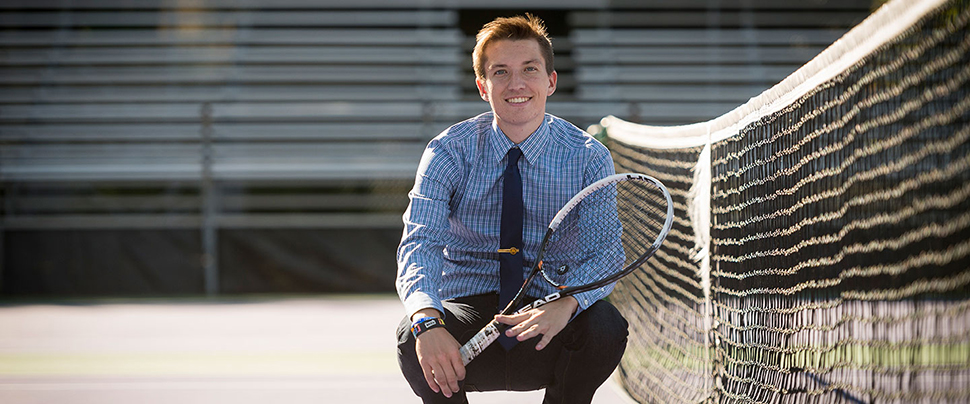One in a series of profiles on undergraduate research at Northwestern.
Tyler Scaletta knows competitive tennis from the perspective of a player as well as a coach. Now, the Northwestern University senior also is learning how to understand tennis from a researcher’s point of view.
“There’s this idea that tennis players are anxious and antisocial by nature,” said Scaletta, who is majoring in both biology in the Weinberg College of Arts and Sciences and education in the School of Education and Social Policy. But the anxiety and antisocial behavior that are fairly common in competitive junior tennis players are, he added, more likely products of the environment in which players compete.
I played tennis competitively, and I’ve coached high school tennis for a few years. I have seen firsthand how the pressure and isolation can get to young players.”
Weinberg and SESP, 2017
A former competitive tennis player and a volunteer junior tennis coach at Lincolnway East High School in Frankfort, Illinois, Scaletta teamed up with fellow undergraduate Julian Matra, a human development and psychological services major in the School of Education and Social Policy, to apply scientific scrutiny to that hypothesis. Research on the competitive nature of tennis is scarce, and the work that has been most cited, Scaletta said, is highly anecdotal. Based on interviews that were not even recorded or coded, that earlier work lacked the rigor required of serious quantitative data collection and translation that Scaletta is learning at Northwestern.
The research compares behavior of young baseball players with that of young tennis players, who spend hours training and practicing on their own, preparing to face opponents one-on-one in tournaments, all without the moral support of a team.
“It’s cutthroat. Your best friend, maybe your only friend, could become your opponent at any time,” Scaletta said. “Add to that overzealous parents and coaches, and the physical and psychological toll, and tennis can be seriously stunting to the social development of a young player.”
Scaletta hopes his research will spur the larger tennis community to take notice and start a conversation about social anxiety disorders among junior competitive players.
“We’re trying to get parents and coaches to think about the connection between competitive practices and how these kids are developing socially,” he said.
The project has made Scaletta acutely aware of the major role that research plays in policymaking and how it influences thinking about a particular issue. He was surprised to learn freshman year that he could take advantage of Northwestern’s Summer Undergraduate Research Grant program to possibly make an even bigger difference in the stressful lives of young athletes who compete in a sport he coaches and cares deeply about.
“I care about kids playing this sport, and it bothers me to think that they might feel alone or lost,” he said.
Read more in a Q&A with Scaletta, who recently spoke to Northwestern News about his research and reflected on his time at Northwestern.
What led you to do this research?
I played tennis competitively, and I’ve coached high school tennis for a few years. I have seen firsthand how the pressure and isolation can get to young players. And there’s a lot of anecdotal evidence about its relationship to the sport. I figured we could test the hypothesis, see if there is anything there.
How did you identify the young tennis players you surveyed?
We collected data at a tennis tournament in the southwest suburbs. The young athletes that compete there play at a fairly high level, so qualifiers are more competitive than at an average tournament.
Our surveys included psychological measures and lifestyle questions to give us data about social anxiety disorder, demographics and specific incidents of tennis habits creeping into social situations.
We also collected surveys from a youth baseball tournament to highlight and control differences between a team sport and tennis. Then we ran an analysis to determine the strength of the relationship between socially anxious traits and playing competitive junior tennis.
What are some of these traits?
They range in severity: reluctance to talk to a new person, feelings of physical stress about social interactions, not being able to talk on the phone or make eye contact.
You played tennis at this age. Were you one of these socially anxious young athletes you and Julian were looking at?
No, I think because my parents encouraged me to try a lot of different activities. I didn’t just play tennis. But if you look at a lot of the kids who are really good tennis players, it’s their only activity. They play for many hours a day and don’t really socialize outside of tennis.
What was it like doing this project with a partner?
We’ve both learned so much about research practices, from writing the proposal, getting it approved and doing the pre-research. But more than that, I’m a big fan of collaboration in general. Together Julian and I have come up with so many ideas that I would never have thought of on my own.
Did you see yourself doing research before coming to Northwestern?
No, not at all. I had never heard of this kind of opportunity for undergrads. Peter Civetta [director of the Office of Undergraduate Research] came into one of my classes freshman year to talk about the undergraduate research program, and I thought it was an awesome opportunity.
Has undergraduate research changed the way you think about your studies?
I always wanted to teach, but now I have an increased interest in educational research. Teaching is a huge impact profession -- one I really care about -- but being exposed to education research has allowed me to see its potential for impact on policy. That area can create the effects I think a lot of people who want to become teachers hope to see.


